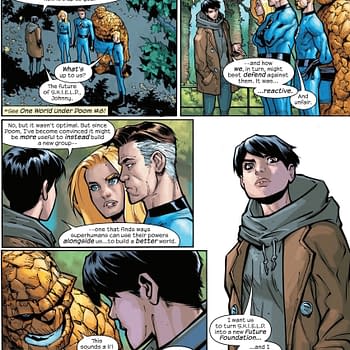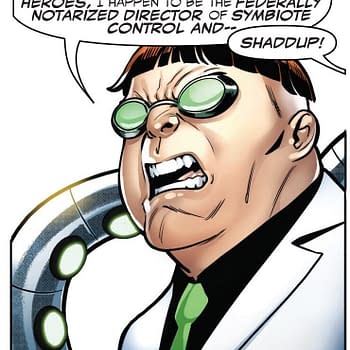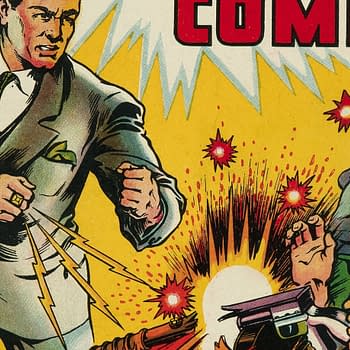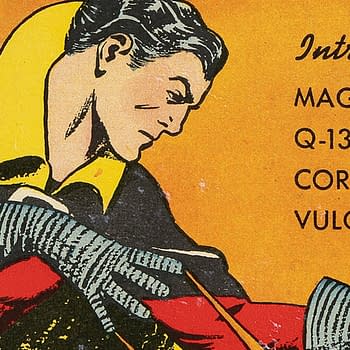Posted in: Comics | Tagged: Comics, dc, entertainment, gendercrunching, marvel
Gendercrunching August 2013 – DC, Marvel And The New York Times Bestseller List
By Tim Hanley
Marvel was down and DC was up, but the changes weren't enough for DC to top Marvel's overall percentage of female creators. We also look at the New York Times graphic novel bestsellers over the past year and see how their numbers stack up against the Big Two.
DC COMICS
There was a nice uptick for DC this month overall, and some good showings by category as well. In August 2013, DC released 73 new comics featuring 663 credited creators, 583 men and 80 women. Here are their stats:
DC was up 0.4% overall, with only slight losses in three categories. Writers fell less than 1% and remained high, inkers fell by a similarly minor amount but remained ridiculously low, and letterers (ie. Saida Temofonte, DC's only female letterer) dropped a couple of percentage points. Cover artists stayed about steady at a good total, though, with small gains for pencillers and assistant editors, a 2.5% jump for full editors, and a rise of more than 3% for colorists. More gains than losses usually makes for a good month, though what happens next month is anyone's guess with so many different creative teams for Villains Month.
Compared To A Year Ago: DC was at 10.1% female creators last August, and has grown 2% since then.
MARVEL COMICS
Marvel fell noticeably in August while still maintaining a high overall total, but there were some especially poor showings by category. In August 2013, Marvel put out 65 new comics with 523 credited creators, 449 men and 74 women. Let's look at the stats:
Marvel set a record high last month so a decline overall isn't a big surprise, but a loss of 0.9% is more than you'd like to see. There were some sizable losses this month, including a complete lack of female interior artists after a relatively strong July and a loss of more than 7% for assistant editors. There were small gains for cover artists, colorists, and editors, and the percentage of female writers more than doubled, but the fewer losses were just too heavy for the gains to overcome.
Compared To A Year Ago: Marvel is up 1.5% from last August, when they were at 12.6% female creators overall.
NEW YORK TIMES BESTSELLING GRAPHIC NOVELS
A little over a year ago, we looked at how the Big Two compared to the books on the New York Times graphic novels bestsellers charts and we saw a stark difference. This comparison gave us a good look at the non-floppy, direct market comic world, and we're going to check in again to see if anything's changed over the past year.
The methodology is simple: I counted up all of the names in the New York Times bestseller lists over the past year (September 2012-August 2013) for both soft cover and hardcover graphic novels for non-DC and Marvel titles. Then I counted up all of the writers and interior artists in DC and Marvel's August 2013 solicits (no cover artists, because the New York Times credits don't mention cover artists). We compare the totals in two ways: First by credits, where a creator is counted as many times as they appear, and then by different creators, where each creator is counted only once regardless of how often they come up. So in the first count there's 200 Robert Kirkmans, and in the second count there's only one. Yeah, Kirkman was on the bestseller list 200 times over the past year. The Walking Dead is RIDICULOUSLY popular.
Of course, bestsellers don't compare directly to the entire lines of DC and Marvel's books because it's a select group versus everything. However, as I said last year, this comparison isn't apples and oranges, but it is all of the apples versus the bestselling apples. It's enough for a broad look at things where we focus on the trends more than the specifics, and the trends are quite clear:
First off, for non-DC and Marvel New York Times bestsellers, a full QUARTER of the credits were female. That is huge. There were several women who appeared regularly, like Raina Telgemeier (79 times), Fiona Staples (42 times), Alison Bechdel (34 times), and Hope Larson (31 times), but there were a lot of other women throughout the charts as well.
The percentage of female creators drops to 15.6% in terms of different creators, which is lower but also says something interesting: Female creators, on average, have more staying power on the sales charts. The average male creator had 7.5 credits, while the average female creator had 13.5 credits. And that's with Kirkman and the rest of The Walking Dead team boosting the male numbers massively. In fact, if you take out the three Walking Dead creators, Robert Kirkman, Charlie Adlard, and Tony Moore, the male average falls to 3.8 credits.
So female creators seem rather popular outside of superhero comic books, showing up in strong numbers and then staying for a while. It seems that female writers and artists are common outside of the Big Two; we've seen similar examples of this at a few smaller comics publishers a few months back. DC and Marvel are lagging far behind.
However, there is a big silver lining to these stats. Let's compare these totals with what we had last year. The darker colors are last year, and the lighter colors are this year:
Everything is higher for female creators! And by big amounts. For all three categories, examined in two different ways, the numbers are up compared to a year ago. Big numbers became huge on the New York Times bestsellers lists, small numbers rose considerably at DC, and while Marvel had the least growth proportionate to last year there was noticeable growth nonetheless.
The number of female creators is growing across the board, with significant changes in even this short period of time. The seismic growth of female creators at the Big Two is inevitable, really. There are so many of them everywhere else, and inevitably they'll make their way into superheroes. They slowly are already. If the executives at the Big Two were smart, they'd throw a pile of money at Raina Telgemeier to try to get her to do a teen superhero book, and then gleefully count the many dollars that would pour in as it sold like hotcakes. Raina Telgemeier's Wonder Girl or Raina Telgemeier's Carol Danvers: Air Force Academy. It's a fortune waiting to happen. She probably wouldn't do it since she's killing it with her own stuff, but it's worth a shot.
To learn more about this statistics project and its methodology click here, and to see the previous stats click here.You can visit Tim at Straitened Circumstancesand follow him on Twitter@timhanley01.


















